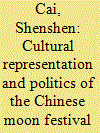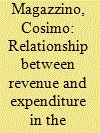|
|
|
Sort Order |
|
|
|
Items / Page
|
|
|
|
|
|
|
| Srl | Item |
| 1 |
ID:
134182


|
|
|
|
|
| Publication |
2014.
|
| Summary/Abstract |
China-Taiwan Relations have become significantly less confrontational since 2008. One of the indicators demonstrating the improvement of their relations is the resumption of the contact between China's Association for Relations Across the Taiwan Straits (ARATS) and Taiwan's Straits Exchange Foundation (SEF) in 2008 after 9 years of no formal interaction. The purpose of this paper is to explore China-Taiwan relations in the period from 1990 to 2008 by examining the interaction between the aforementioned two organizations which were founded in 1991. By analyzing the relevant official announcements and statements made by China and Taiwan in the period from 1990 to 2008, this paper finds that China became more hostile toward Taiwan and therefore its ARATS in turn was unwilling to negotiate with Taiwan's SEF when it perceived that the Taiwanese government was pushing for Taiwan's independence. By contrast, when it perceived that the Taiwanese government was more compromising on the issue of Taiwan's independence, it became relatively conciliatory and its ARATS in turn was more willing to interact with Taiwan's SEF.
|
|
|
|
|
|
|
|
|
|
|
|
|
|
|
|
| 2 |
ID:
134183


|
|
|
|
|
| Publication |
2014.
|
| Summary/Abstract |
Nationalism in various forms has been a fixture of modern Chinese politics and society; however, its form has changed and over the past decade or so, the CCP has begun to appropriate China's cultural nationalism through its extensive use of propaganda and by other less nefarious methods. This paradigm shift embodies the deliberate manoeuvring that state nationalism is exerting on cultural symbols, concepts and legacies in China. Through imagery and emotionally laden political marketing that favour Party policy and rule, this form of nationalism surreptitiously caters to the cultural tastes of, and appeals to, the emerging middle class of contemporary Chinese society. It is a more nuanced and creative type of propaganda. Using the 2009 China Central Television (CCTV) Moon Festival (Mid-Autumn Festival) Gala as a case study, this paper examines Party-state appropriations of cultural nationalism. The Gala is a rich reservoir of moon-inspired traditional Chinese cultural elements, and the intriguing manoeuvring of these culturally bound images and iconography signifies a new propaganda strategy that combines poetic nostalgia, poignant romance and abstract philosophical pursuit, through which cultural elements are skilfully woven into a patriotic and nationalist appeal. These traditional cultural signifiers, illusions and fantasies serve the Party's political aims as it attempt to reinforce its legitimacy by forging a culturally bound national identity.
|
|
|
|
|
|
|
|
|
|
|
|
|
|
|
|
| 3 |
ID:
134180


|
|
|
|
|
| Publication |
2014.
|
| Summary/Abstract |
In this paper, we argue that the two Koreas' intentions and actions on the cyber front point toward the possibility that they have engaged in cyber warfare against each other. From South Korea's standpoint, a key concern has been North Korea's advanced cyber warfare capabilities and alleged involvement of its substantial workforce in the Internet's dark side activities. These issues need to be looked at the backdrop of the North's nuclear and ballistic missile capabilities. This paper draws principally upon theories and concepts from military strategy and warfare to examine the contexts, mechanisms, and processes associated with the cyber warfare in the Korean peninsula. We also compare the two Koreas in terms of various forms of asymmetries in cyber warfare and cyber attacks. Also highlighted in the paper are South Korea's recent initiatives and actions to enhance cyber-offense and cyber-defense capabilities.
|
|
|
|
|
|
|
|
|
|
|
|
|
|
|
|
| 4 |
ID:
134179


|
|
|
|
|
| Publication |
2014.
|
| Summary/Abstract |
In a globalized world characterized by direct interactions among states of different capacities, regional relationships must be considered in terms of their broader global context. States cannot change their location; therefore, engagement with neighbors has a particular importance in terms of present relations, historical memories, and future prospects. States are more anxious in a multinodal world because of increased regional and global exposure. However, it would be imprudent for them to act aggressively or to self-isolate because such behavior limits the potential for future beneficial exchange. In a multinodal world, partnerships are more rational than alliances. In East Asia, relationships will be asymmetric as in the past, but they should also be based on sovereign equality and global inclusiveness.
|
|
|
|
|
|
|
|
|
|
|
|
|
|
|
|
| 5 |
ID:
134181


|
|
|
|
|
| Publication |
2014.
|
| Summary/Abstract |
The aim of this study is to assess the relationship between revenue and expenditure in the ASEAN countries. Using annual data for the period between 1980 and 2012 in ten member states, a long-run relationship between government expenditure and revenue emerges, both in ASEAN-6 and ASEAN-10 countries. Granger causality analysis shows mixed results, even though for five ASEAN countries the predominance of "tax-and-spend" hypothesis exists, given that government revenue drives the expenditure. Moreover, mixture models seem to produce homogeneous groups, considering the socio-economic structure, welfare state, and historical aspects. Finally, convergence measures show interesting results, confirming the sample's heterogeneity.
|
|
|
|
|
|
|
|
|
|
|
|
|
|
|
|
|
|
|
|
|